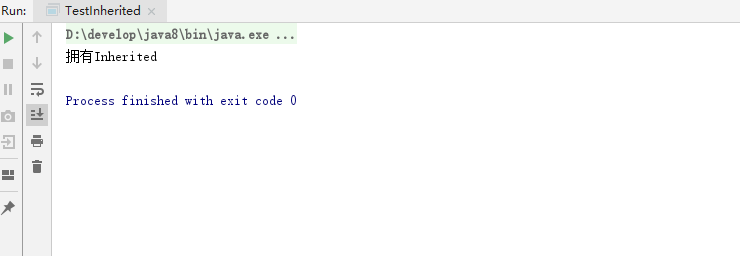java元注解@Inherited的使用详解
1.先看源码文档
/**
* Indicates that an annotation type is automatically inherited. If
* an Inherited meta-annotation is present on an annotation type
* declaration, and the user queries the annotation type on a class
* declaration, and the class declaration has no annotation for this type,
* then the class's superclass will automatically be queried for the
* annotation type. This process will be repeated until an annotation for this
* type is found, or the top of the class hierarchy (Object)
* is reached. If no superclass has an annotation for this type, then
* the query will indicate that the class in question has no such annotation.
*
* <p>Note that this meta-annotation type has no effect if the annotated
* type is used to annotate anything other than a class. Note also
* that this meta-annotation only causes annotations to be inherited
* from superclasses; annotations on implemented interfaces have no
* effect.
*
* @author Joshua Bloch
* @since 1.5
* @jls 9.6.3.3 @Inherited
*/
@Documented
@Retention(RetentionPolicy.RUNTIME)
@Target(ElementType.ANNOTATION_TYPE)
public @interface Inherited {
}
上述代码注释部分可以用谷歌翻译大法大致意思是
表示注释类型自动继承。 如果在注释类型声明中存在继承的元注释,并且用户在类声明上查询注释类型,并且类声明没有此类型的注释,则该类的超类将自动查询注释类型。 将重复此过程,直到找到此类型的注释,或者达到类层次结构(Object)的顶部。 如果没有超类具有此类型的注释,则查询将指示所讨论的类没有这样的注释。
请注意,如果使用注释类型来注释除类之外的任何内容,则此元注释类型不起作用。 还要注意,这个元注释只会导致从超类继承注释; 已实现的接口上的注释无效。
通过上述描述可知,使用该注解的注解父类的子类可以继承父类的注解。
2.代码测试
2.1拥有@Inherited注解
@Target(ElementType.TYPE)
@Retention(RetentionPolicy.RUNTIME)
@Inherited
public @interface InheritedTest {
String value();
}
@InheritedTest("拥有Inherited")
public class Person {
public void method(){
}
public void method2(){
}
}
public class Student extends Person {
}
测试:
public class TestInherited {
public static void main(String[] args) {
Class<Student> studentClass = Student.class;
if (studentClass.isAnnotationPresent(InheritedTest.class)){
System.out.println(studentClass.getAnnotation(InheritedTest.class).value());
}
}
}
输出:

2.2未拥有@Inherited注解
@Target(ElementType.TYPE)
@Retention(RetentionPolicy.RUNTIME)
public @interface IsNotInherited {
String value();
}
@IsNotInherited("未拥有Inherited")
public class Person {
public void method(){
}
public void method2(){
}
}
public class Student extends Person {
}
测试:
public class TestInherited {
public static void main(String[] args) {
Class<Student> studentClass = Student.class;
if (studentClass.isAnnotationPresent(IsNotInherited.class)){
System.out.println(studentClass.getAnnotation(IsNotInherited.class).value());
}
}
}

没有输出任何任容,由此可知未拥有@Inherited注解的注解的类的子类不会被继承该注解。
以上就是本文的全部内容,希望对大家的学习有所帮助,也希望大家多多支持我们。
赞 (0)

